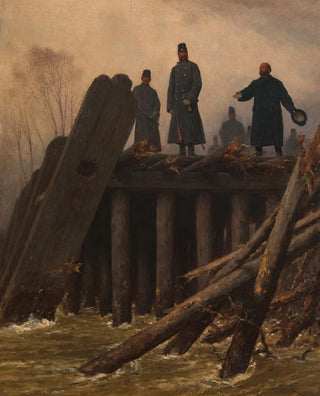Art print | The February 1862 Flood - August von Pettenkofen


View from behind

Frame (optional)
Art print of the February 1862 flood - August von Pettenkofen – Captivating introduction
In the rich and varied panorama of art history, some works manage to capture moments of emotion and drama with unforgettable intensity. "The February 1862 flood" by August von Pettenkofen fits perfectly into this category. This painting, which evokes a devastating natural disaster, immerses us in an atmosphere where nature runs wild, revealing man's vulnerability in the face of its forces. The scene, both tragic and fascinating, invites us to reflect on the human condition and the fragility of our existence. Through this work, Pettenkofen succeeds in capturing not only the disaster but also the resilience of those who witness it.
Style and uniqueness of the work
August von Pettenkofen's style is characterized by meticulous attention to detail and a vibrant color palette that breathes life into his compositions. In "The February 1862 flood," the artist uses dark and dramatic tones to emphasize the anxiety and desolation that dominate the scene. The characters, frozen in poses of despair and struggle, testify to the emotional impact of the catastrophe. Pettenkofen's technique, blending realism and expressionism, allows one to almost physically feel the rising waters and the ensuing panic. Every brushstroke seems charged with tension, transporting the viewer to the heart of the event, as if they were a direct witness to this tragedy.
The artist and his influence
August von Pettenkofen, an Austrian painter of the 19th century, is often regarded as a master of realism. His ability to depict scenes of everyday life with such emotional depth marked his era and continues to inspire many contemporary artists. Beyond his talents as a painter, Pettenkofen was also a keen observer of social and political events of his time. His work bears witness to a sharp sensitivity to human suffering, and "The February 1862 flood" is a striking example. Through this piece, he manages to transcend

Matte finish

View from behind

Frame (optional)
Art print of the February 1862 flood - August von Pettenkofen – Captivating introduction
In the rich and varied panorama of art history, some works manage to capture moments of emotion and drama with unforgettable intensity. "The February 1862 flood" by August von Pettenkofen fits perfectly into this category. This painting, which evokes a devastating natural disaster, immerses us in an atmosphere where nature runs wild, revealing man's vulnerability in the face of its forces. The scene, both tragic and fascinating, invites us to reflect on the human condition and the fragility of our existence. Through this work, Pettenkofen succeeds in capturing not only the disaster but also the resilience of those who witness it.
Style and uniqueness of the work
August von Pettenkofen's style is characterized by meticulous attention to detail and a vibrant color palette that breathes life into his compositions. In "The February 1862 flood," the artist uses dark and dramatic tones to emphasize the anxiety and desolation that dominate the scene. The characters, frozen in poses of despair and struggle, testify to the emotional impact of the catastrophe. Pettenkofen's technique, blending realism and expressionism, allows one to almost physically feel the rising waters and the ensuing panic. Every brushstroke seems charged with tension, transporting the viewer to the heart of the event, as if they were a direct witness to this tragedy.
The artist and his influence
August von Pettenkofen, an Austrian painter of the 19th century, is often regarded as a master of realism. His ability to depict scenes of everyday life with such emotional depth marked his era and continues to inspire many contemporary artists. Beyond his talents as a painter, Pettenkofen was also a keen observer of social and political events of his time. His work bears witness to a sharp sensitivity to human suffering, and "The February 1862 flood" is a striking example. Through this piece, he manages to transcend






